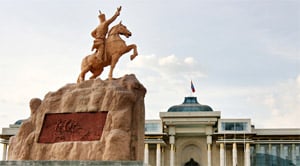MILESTONES: MONGOLIA
By Thomas Clouse
Mongolia’s economy grew at a record-setting pace in 2011, bringing optimism for improved living standards—and concerns about overheating.

In February the World Bank cited 2011 GDP growth at 17.3%, up from 6.4% in 2010. Unemployment also dropped to 9%, down from 13% in 2010, and foreign direct investment poured into the country, especially into the mining industry. Total FDI hit $5.3 billion, equal to 63% of GDP.
Government spending was a primary driver of growth, rising by 56%. The new spending was largely offset by increased revenue, but pro-cyclical policies led the World Bank to warn of potential overheating. Inflation topped 11% year-on-year in December, pushing real wage rates into negative territory for unskilled workers in the urban informal sector. Bank lending also expanded, with outstanding loans up 72% in December.
Mongolian policymakers passed two laws recently to address overheating concerns. The Integrated Budget Law, passed in December, sets out a legislative budget-making process and includes measures to sustain government finances throughout the boom and bust cycles of Mongolia’s mining industry.
Passed in January, the Social Welfare Law will replace direct cash transfers to citizens with defined welfare benefits. The former cash transfer policy, an effort by lawmakers to distribute wealth from rising tax revenue to its citizens, fueled price growth, encouraged government dependency and inflated government spending. The new law, when implemented midyear, will offer benefits for approximately 130,000 of Mongolia’s poorest households.
Mongolia is also taking steps to move away from its dependence on mineral exports, starting construction in March on a wind farm project that is expected to provide around 5% of the country’s energy, when completed. A January report from Mongolian investment company Newcom estimates that the country’s total alternative energy production could potentially reach 2.6 million megawatts of power annually, equal to 66% of the world’s total 2009 alternative energy production.



